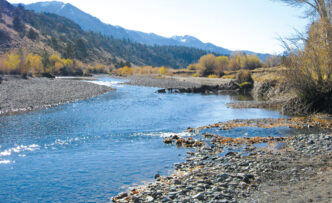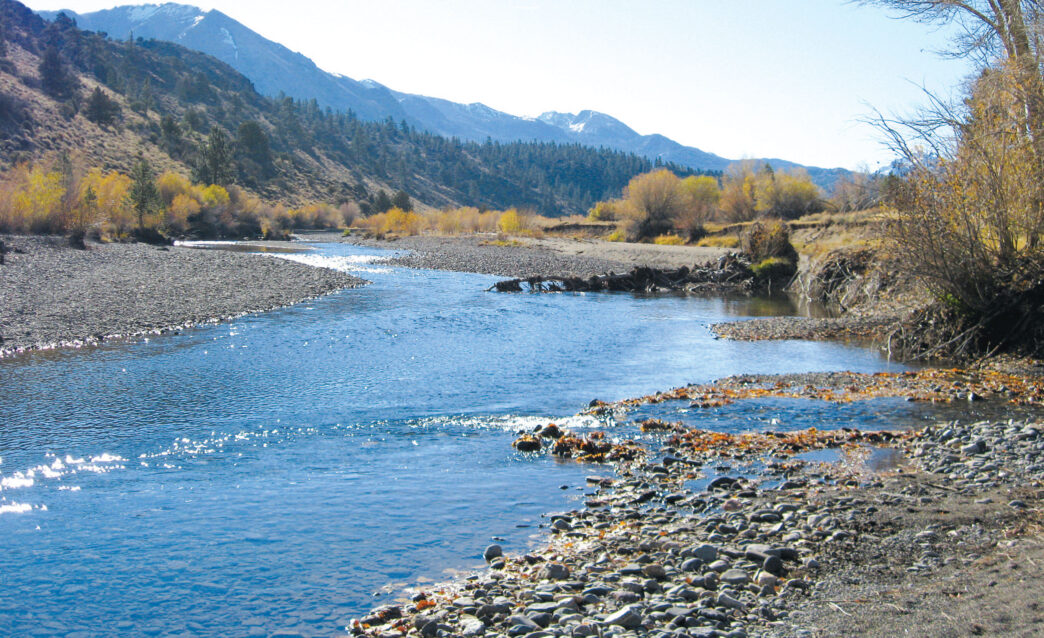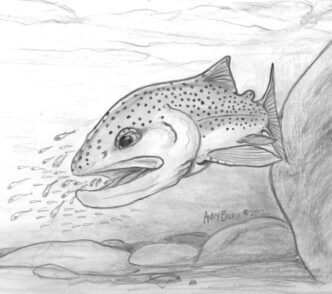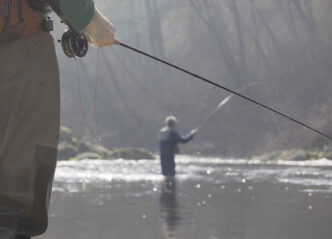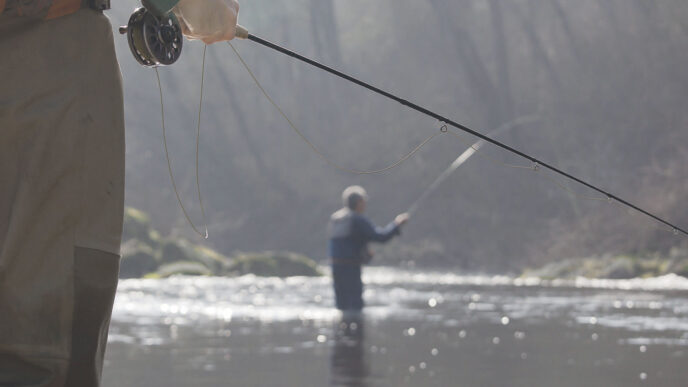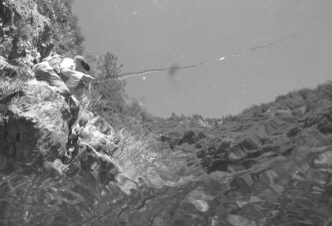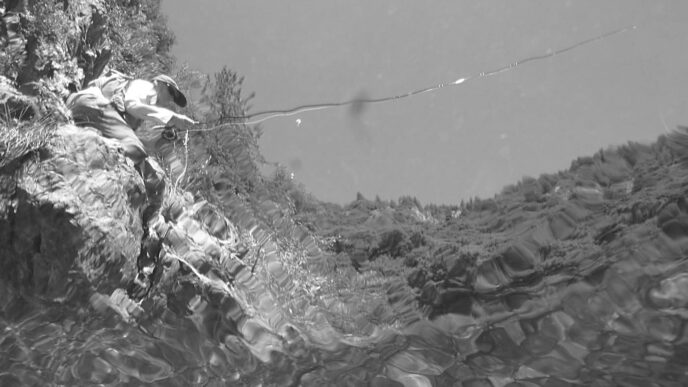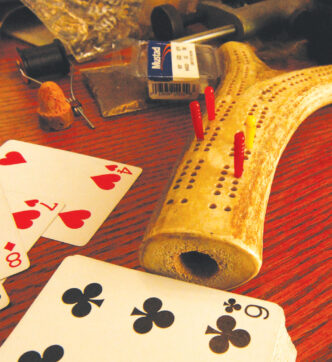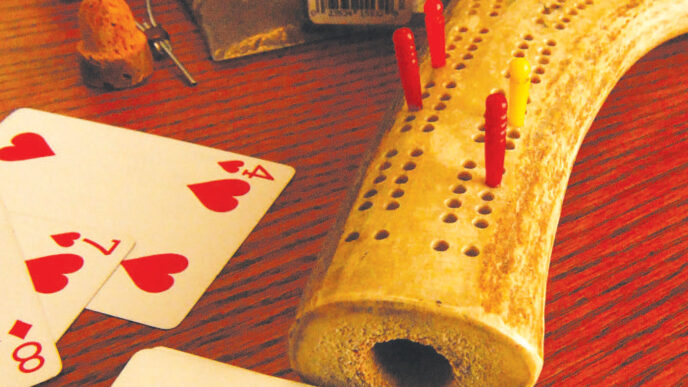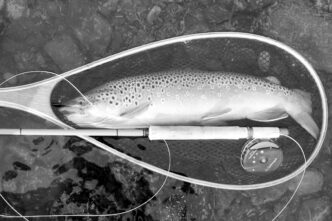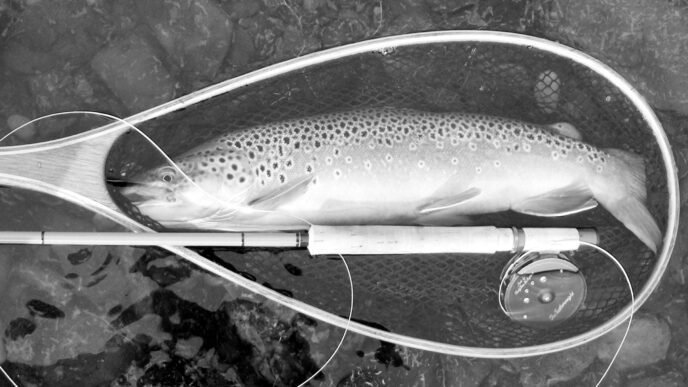Every now and then, I meet someone who is nice enough to tell me that they have read one of my articles. Often, they tell me how lucky I am that I get to do all of my fishing in the backcountry. If only that were so. It is true that I am fortunate to live a lot closer to the trailheads and access points than most people, but true backcountry fishing is not the rule for me.
There are several reasons for this. The first relates to snow cover. In a big snow year such as 2010–2011, the high country may not be open until mid-July or even August. I recall one pack trip on which we were the first group over Gem Pass on August 10. At the other end of the season, early snows can shut things down in October. The result is that the season can be as short as three months. At the same time, I am amazed at how my calendar fills up with “important” appointments and commitments that mean the opportunities for multiple-day excursions become fewer and farther between than I would like.
Even long day trips are not always possible. I want to maximize my backcountry opportunities, so I end up demanding long days. Paradoxically, this means that I put limits on the number of days that I deem available for such trips. (Perhaps I just learned an important lesson here.) These long day trips are a bit more involved in terms of preparation. Although I try to keep my day pack at the ready at all times, I seem to lack faith in my own efforts and end up wanting to empty it out and repack it for each trip. Weather conditions mean that clothing must be swapped out, food needs to be considered, and the bottom line is that I don’t have grab-and-go figured out very well. At any rate, this means that most of my fishing is done in less than full-day increments that I fit in among other activities.
My backcountry fishing, consequently, has evolved from being about physical destinations toward being a state of mind. What that means is that I seek to become completely absorbed in what I am doing, which is rare for me, because I have one of those minds that is continually noisy. My first experience with this sense of quiet came on a wilderness backpacking trip many years ago, and it is an association that still exists. When I plan trips, this backcountry state of mind has become the goal.
For starters, I am looking for an absence of other anglers. It is best if there are no other people at all, but if there are people out walking, picnicking, or looking at flowers or fall colors, I have learned that they are as willing to ignore me as I am them. It is always good if there is wildlife available, which usually means birds of some kind. The overall scenery or setting factors in, as well.
Over time, I have learned that I can reach my backcountry mindset without having to commit to a several-hour walk from the car or a long trip to a trailhead from town. Four days from the past year can serve as examples.
A Spring Day on a Small Stream
Shortly after a major holiday weekend on which Highway 395 was filled with every conceivable model of SUV and recreational vehicle, I just needed to fish.
On a day with a full morning, I could fit a few hours on the water into the afternoon. It was early in the season, with a big snowpack, but I thought I could avoid the hassle of dealing with streams swollen by snowmelt by fishing the outflow of an impoundment. Such flows do not necessarily reflect the time of year, but rather decisions made in a far-away operations center. Early in the season, these impoundments serve to retard the results of snowmelt. Later in the year, downstream demands can lead to flows that are far higher than would be expected. (I like to visit online stream flow sites to figure out where conditions are closest to optimal.)
On this day, I drove for 20 minutes out of Bishop, where I live, and parked the car next to a bridge over my target stream. The road parallels this stream for many miles. Only a little bit of the stream is visible from the bridge, and it is not very inviting. I often fish this stretch of water. The majority of the time, I will not see another angler during the hours I am there.
The first task here is to push through a thick barrier of willows to a starting point where tailout rapids from an upstream pool undercut the far bank before turning into a broad eddy pool below. Willow branches hang over the water across from me there and rise up directly at my back. It is not an easy place to fish, but I’ve consistently found trout, either clumped up under the far bank or dispersed out into the main current. I start here every time, so my familiarity with the water lets me begin fishing without having to give the situation a lot of thought. Rig up, tie on a dry fly such as a Stimulator, Cutter’s Perfect Ant, or parachute pattern, and try to make some casts. The challenge is to focus right away and not be sloppy.
Hidden in the willows, I can spend half a day working less than half a mile of water and become fully absorbed with the sights and sounds of the stream. There are usually a lot of birds there — I hear many more of them than I see, but it is a challenge to identify them by sound. Upstream are several smaller pools connected by a stretch of faster water with two defined current slots. Fish are scattered all over, and each cast is a bit demanding. They’re mostly brown trout, and some of them are surprising large. Although I don’t feel the pressure that can come with angling for known big fish, I need to concentrate, and that, in turn, clears my mind. Three and a half hours and maybe half a mile later, I come out from the stream knowing exactly why I am so fortunate to be able to fish these places.
Beyond the Culvert
Later that year, I had delivered my wife to a workshop she was attending and had another afternoon at my disposal. I had planned to check out a destination water nearby. When I got there, I found what appeared to be a used car lot spread out up and down the road. Time for Plan B. Fifteen minutes later, I crossed a culvert over a stream that I had seen many times. Each time, I had wondered what was up with this little waterway. I parked on the shoulder and looked out at masses of willows on both sides of the road. I knew that there was a creek in there someplace and began to crash through the vegetation. I finally found the creek at an S curve with a pool and undercut banks at both ends, connected by a riffle. I could see the backs of trout in the shallower water. Willow and tree branches were everywhere. I hate it when the first cast is demanding, but I managed to put an emerger sort of thing in the right place and was rewarded with a swirl. I missed the fish by striking too soon. It took three repetitions before I figured out that I needed to be deliberate in my hook sets. When I finally connected, I was surprised to find that the trout was nearly a foot long, brightly colored, and chunky. I spent almost an hour working through the two pools and their connecting water. The fish were where they should have been and were willing, but not stupid. Finding a place where I could cross the creek, I climbed up a ridge to try to get a better view of things. When I looked down, I could see where the stream coursed through the willows and got a sense of how to get from spot to spot. The next two hours were a repeat of the first, and I was a happy guy when I returned to the car. I had caught more than enough fish, all scrappy, bright-yellow browns, and had seen some interesting birds. The only other thing fishing was a heron, which seemed to be doing quite well. And did I mention that I had been fishing through a campground?
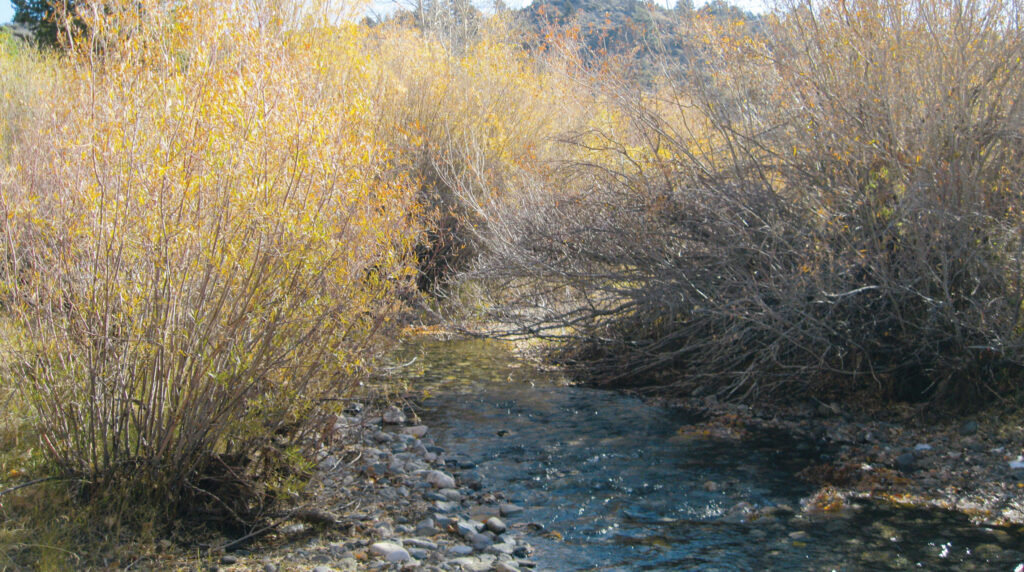
Going Off Trail
Another day, another campground. A lot of people must walk around there, because there are use trails that run along the stream. However, because of vegetation and topography, the trails often pull away from the stream, rather than running beside it. Although there are a few places where you can easily get to the water, you mostly have to scramble because of willows, deadfalls, bogs, or steep banks. I start at my normal entry point, where the stream is wide, flowing into a large pool not far upstream from the roadway. I can see that a lot of people fish this pool at the bottom end, near the road, but not from here. If you wade out into the current, you can fish into some pockets above the pool and then drift a fly downstream into the head of the pool and the eddy. Fish respond to dry flies, but I have also fished here with beadhead nymphs and Woolly Buggers or Matukas. There are some large fish in this creek, and not just by the road.
Working upstream through bushes and mud, I can spend two or three hours on his stream and usually can depend on taking fish. There are views of the Sierra Crest at every turn. The riparian habitat, perhaps thanks to the beavers, attracts a great many birds, and on this day, they were claiming territories and mates. It was like being in the middle of an unending bird song. In half a mile there is an example of almost every type of water that you find on a trout stream, which gives you an opportunity to try a variety of techniques and patterns. I always leave feeling pretty good about the world and my place in it.
Fishing Near Town
Not long ago, I had two meetings in town. One started at 8:00 A.M. and the other at 3:00 P.M., leaving time to kill. After a short drive, I was walking toward where I knew there was a trout stream. Once again, I had parked the car near a bridge and struck out into the vegetation. I came out at a gravel bar with a backwater across the way that looked like a beaver pond. It was nearly impossible to see over the high banks, and I was isolated next to the rushing water — no one else was around. I could see no riseforms, so I decided to fish subsurface with a small beadhead midge pattern. I don’t much like to fish with nymphs because I am not very good at it, because I don’t do it very often, because I don’t much like it — not a recipe for either success or progress.
Amazingly, on this day, it was as if I knew what I was doing. I could see the strikes and was able to react well enough to hook up with some strong and very satisfying trout. There were a lot of them packed into the current seam, and they were not disturbed by playing and landing nearby fish. An hour or so later, trout began to rise, and I was able to turn to dry flies and continued to make contact with fish until I had to leave for my afternoon appointment. It is true that the fish taken with nymphs were larger, but fun is fun. It was a brilliantly warm and clear day, birds were moving, and my field scribbles tell me that I saw more than a dozen species. I spent the entire time by myself.
Lessons Learned
On each of these occasions, I was able to capture a sense of being away in a wilderness, even though I quite clearly was no more than 15 or 20 minutes from a bunch of people, stores, and other distractions of daily life. And these were just four examples from a limited geographical area. There are many, many more, scattered throughout the Sierra.
Still, I would not visit these places at just any time. For much of the year, they simply would not be inviting in any sense because of the people that their locations near roads and bridges would attract. The trick is to look at several factors to determine if the time is right.
To begin with, you have to maintain an open mind when looking for possibilities. My four streams are not much to look at where they first come into view. They are certainly not the eastside icons that fill guide and fly-shop brochures. Although their overall settings are attractive (they are in the eastern Sierra, after all), the visible flows do not scream out “Fish me!” If you spend a lot of time fishing remote and pristine waters, you can lose sight of the fact that the more unassuming places close at hand can yield some really enjoyable days. It would seem obvious that you have actually to get onto the water to determine if it is worth fishing, but I have seen people stop at the places I talked about, look out the windows of their cars, comment that the world is going to hell in a basket, and drive away. I derive a sense of pleasure from this, because you have to be willing to risk disappointment in order to ferret these places out. Many people fish only the water they can see from the road. It does not occur to them that there is more around the bend or down where the stream drops into a little canyon whose access is not obvious.
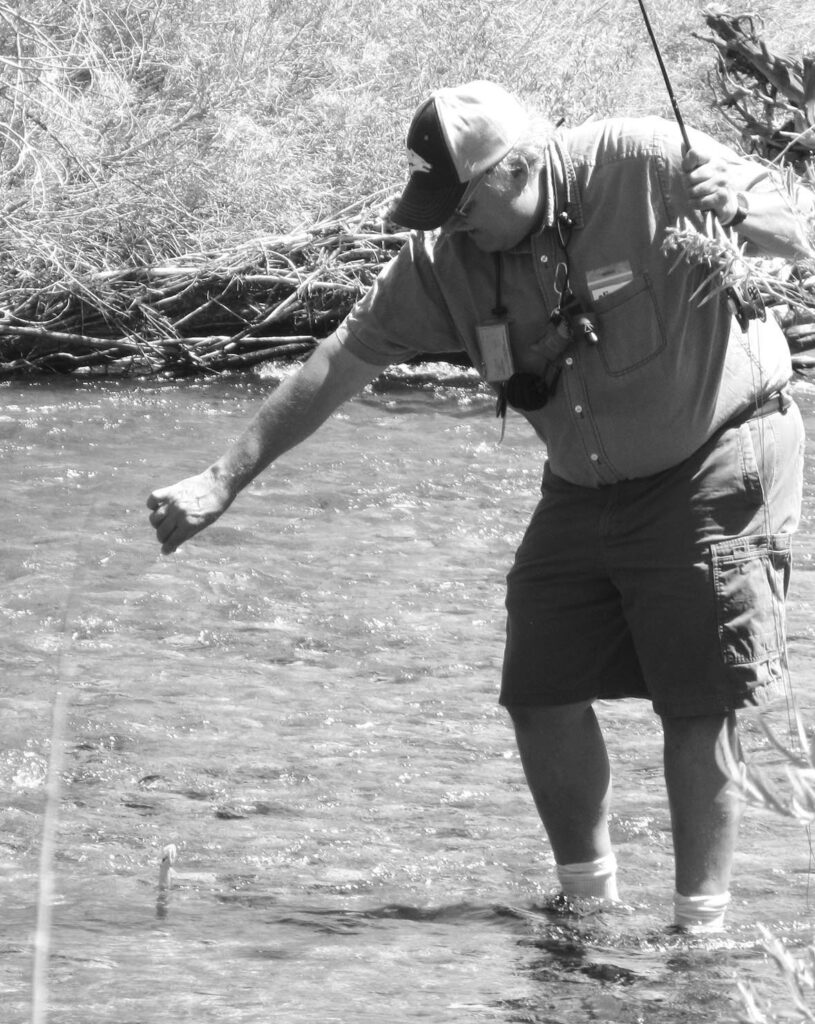
Bear in mind that the construction of a bridge or culvert generally does not enhance any stream at the area of construction. This is less true now, due to newer policies and concepts, but these things were not worried about so much 50 or more years ago. What this means, though, is that what you see from the road is not at all representative of what might be found with a little exploration. Maybe this place does not merit a whole day as a destination, but as a diversion for part of an afternoon or at the end of the day, it might be just the ticket.
When people do fish places like these, lots of folks run down to the water where access is easiest, make a few casts, and then leave within 30 minutes or an hour. If you avoid the obvious spots with easy access, though, you end up fishing a completely different creek. Look for the places that are hard to reach or hard to fish. “Use trails” commonly lead from easy access to easy access and skirt areas that are clogged with heavy willow growth, extensive deadfalls, uneven terrain, steep banks, and swampy bogs. When the easy access moves away from the water, you want to take the hard turn and plunge forward. This can make for some heavy going, even though you might be only a hundred yards from the car. I once spent an hour by myself on maybe 50 yards of creek that was surrounded by swamp in a campground in mid-July. I can’t imagine camping there because of the bugs, but the fishing was very rewarding. You need long sleeves and pants and a brimmed hat to avoid being scratch by heavy vegetation, and don’t skimp on insect repellant to deal with the bugs in those boggy areas.
To be sure, there are times when these little streams are pounded pretty hard. After all, two of them that I mentioned run right through campgrounds. Evidence of the impact of people is visible in terms of use trails and, sometimes, debris. However, this is not the case throughout the entire season. You can avoid people by means other than walking great distances away from them.
Consider temporal avoidance. There is no way I would go near any of my secret places from July through mid-September. Happily, this coincides with the period when the more remote backcountry areas are accessible. I plan on fishing the kinds of places I’m talking about here early and late in the year.
You need to be flexible about weather conditions, too. Just the threat of a storm will go a long way toward clearing away crowds. By preference, I often find myself fishing in snow or rain. Because water temperatures change more slowly than those of the air, and many stream temperatures are affected by impoundment releases, there is often insect activity that prompts responsive trout on days where I am dressed in enough layers to look like the Pillsbury Doughboy.
Many people restrict their activities to preconceived periods of the calendar. This is why spring skiing is relatively uncrowded. In the minds of many people, skiing season ends long before the good snow is gone. The same is true for people who fish. Their decisions to fish are not made so much on conditions on the stream as on the calendar. “Not-fishing season” is a good time to try some close-in opportunities. You can get clues to these times by checking out campground opening and closing dates, dates when various permits are required, and resort occupancy rates.
Obviously you want to avoid any of the big fishing events: opening weekend, Memorial Day, Father’s Day, July Fourth, and Labor Day. The same is true for the last two weeks before school opens. Even better, avoid the weekend altogether and get out midweek. Regardless of the date, get on the water during mealtimes. If I don’t eat dinner, I avoid those who do. Most people who fish like to do so during business hours. However, there are opportunities for solitude early and late. Even 15 minutes as the last person out in the gathering dark can provide an experience that is the highlight of the day.
There are all kinds of fishing experiences, and every one of them has an important place in the fishing year. For me, I always want to spend some time on our local premier streams, with their large fish and equally large crowds. One is the price paid for the other. A season without a weeklong trip fishing for wild trout deep in a wilderness setting would be disappointment for me. Throw in some overnights and long day hikes, as well. But that still leaves a bunch of time in little doses — the ends of days spent somewhere else or the few hours here and there when I can sneak away for a quick stream fix. I don’t want to treat these moments as throwaways. What is the point of being on the stream if you don’t find the rewards you are seeking? My reward is the opportunity to enter a quiet, focused state of mind, a backcountry state of mind, and thankfully, it is found in many more places than you might think.



